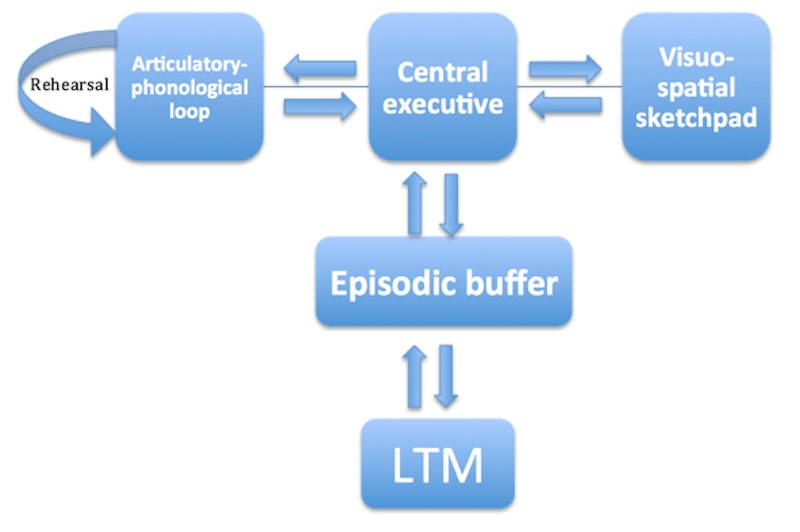Study Notes
Working Memory Model
- Level:
- AS, A-Level
- Board:
- AQA, Edexcel, OCR, IB
Last updated 7 Nov 2023
Baddeley and Hitch (1974) developed the Working Memory Model (WMM), which focuses specifically on the workings of short-term memory (STM).
Atkinson and Shiffrin’s Multi-Store Model of memory (MSM) was criticised for over-simplifying STM (as well as LTM) as a single storage system, so the WMM alternative proposed that STM is composed of three, limited capacity stores:
- Central Executive – this manages attention, and controls information from the two ‘slave stores’ [below]
- Articulatory-Phonological Loop – this temporarily retains language-based information, consisting of:
- An articulatory rehearsal process (‘inner voice’) of language, including any language presented visually to convert to a phonological state, for storage in the:
- Phonological store (‘inner ear’), which holds auditory speech information and the order in which it was heard (or any visually-presented language converted by the articulatory process)
- Visuo-Spatial Sketchpad – this temporarily retains visual and spatial information

A later addition was the episodic buffer which facilitates communication between the central executive and long term memory.
The three-store STM stemmed from research using a ‘dual-task technique’ (or ‘interference tasks’), whereby performance is measured as participants perform two tasks simultaneously. The following observations provided evidence to suggest different, limited-capacity STM stores process different types of memory:
- If one store is utilised for both tasks, then task performance is poorer than when they are completed separately, due to the store’s limited capacity e.g. repeating “the the the” aloud and reading some text silently would use the articulatory-phonological loop for both tasks, slowing performance.
- If the tasks require different stores, performance would be unaffected when performing them simultaneously e.g. repeating “the the the” aloud whilst performing a reasoning task (requiring attention, i.e. the central executive), or whilst following a mobile stimulus with your eyes (using the visuo-spatial sketchpad).
Evaluation of the Working Memory Model
Strengths
- The WMM provides an explanation for parallel processing (i.e. where processes involved in a cognitive task occur at once), unlike Atkinson and Shiffrin’s MSM.
- A Shallice and Warrington (1974) case study reported that brain-damaged patient KF could recall verbal but not visual information immediately after its presentation, which supports the WMM’s claim that separate short-term stores manage short-term phonological and visual memories.
- The model was developed based on evidence from laboratory experiments, so confounding variables could be carefully controlled to produce reliable results (that can be replicated).
Weaknesses
- Despite providing more detail of STM than the multi-store model, the WMM has been criticized for being too simplistic and vague, e.g. it is unclear what the central executive is, or its exact role in attention.
- Results from laboratory experiments researching the WMM will often have low ecological validity (i.e. may not relate to real life), as tasks such as repeating ‘the the the’ are arguably not representative of our everyday activities.
You might also like
Duration
Study Notes
Duration of Short-term Memory
Study Notes
Types of Long Term Memory
Quizzes & Activities
Multi-Store Model of Memory
Quizzes & Activities
Memory - Key Term "Conundrum" Activity
Quizzes & Activities
Memory - "Connection Wall" activity
Quizzes & Activities
Related products
-
 Revision Guides
Revision GuidesAggression Exam Buster Revision Guide for AQA A Level Psychology
03-4130-30566-03
£5.95 -
 Revision Guides
Revision GuidesForensic Psychology Exam Buster Revision Guide for AQA A-Level Psychology
03-4130-30324-01
£5.95 -
 Revision Guides
Revision GuidesBiopsychology Exam Buster Revision Guide for AQA A-Level Psychology
03-4130-30181-03
£5.95 - View full selection ›
Daily Email Updates
Subscribe to our daily digest and get the day’s content delivered fresh to your inbox every morning at 7am.
Signup for emails